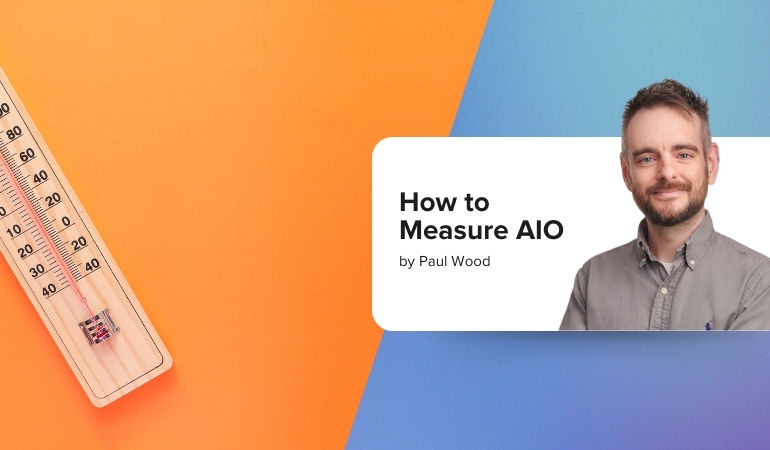Tracking SEO performance is easy. SEO is all about helping a brand and its content appear in search results, and there’s a well-established ecosystem of tools to enable the tracking of this:
- Rank tracking tools show how a website performs for target search terms
- Analytics platforms measure how much traffic comes from search
- Market tools like SEMrush or Ahrefs provide a high-level view of brand visibility
AI tools, though, are on a path to replace, or at least supplement, how people search for information, and it’s leaving marketers with a tracking challenge.
The challenge of tracking AI performance
Marketers have been conditioned to think in terms of rankings, impressions, clicks, and visits. These are all very meaningful and, mostly, accessible metrics in search.
They don’t, however, apply so well to AI.
A question asked via ChatGPT doesn’t generate a ‘ranking’. It doesn’t necessarily generate a click or a visit. The concept of an impression is also much looser; the impression could be the mere mention of a brand name, it could be a full history of the brand, it could be anything in between.
The outputs from AIO (AI Optimisation)
When a person searches for something on Google, there are various points of data generated:
- An impression of a search result
- The ‘ranking position’ of the search result
- A click on a search result
- A visit from a user resulting from the click
When it comes to a search carried out on an AI tool, such as ChatGPT, the data generated could be:
- A mention of an entity (a brand, person, thing, place…)
- A link to a web page
- The context of any mention or link (is it positive or negative in tone? Is it alone, or alongside other ‘things’?)
When looking at it like this, classic search feels like consulting a directory. AI search feels like asking a knowledgeable assistant who phrases things their own way.
How do we track that?
The perception gap between SEO and AIO
It’s worth addressing what I’m calling the ‘perception gap’.
Both traditional search tools and AI-driven tools like ChatGPT produce their results in real time. The process works like this:
- A user searches for something
- The platform queries its ‘knowledge base’
- It generates a result
How it feels to the user, though, is very different.
When searching using Google, it feels as though the list of results is pre-prepared, just waiting to be searched for.
This is far less true with ChatGPT where the result always feels unique.
The perception is further entrenched because when using Google, it’s much easier to generate similar results for a particular search again and again, than with ChatGPT where the results can differ wildly in terms of format and content.
The main takeaway is that, whilst theoretically the two platform types are similar, in practice, it’s usually far easier to create repeatable results on Google than it is when using ChatGPT et al.
In short, tracking SEO is simpler than tracking AIO.
How to track AIO
While SEO gives us clear, quantifiable metrics (rankings, impressions, traffic). AIO is more about interpreting patterns over time.
So, to track AIO performance, we need to rely on a wider range of metrics. It also helps to think of these metrics as ‘signals’. It’s a simple reframing, but it helps to communicate the challenge; pinning down quantitative metrics is harder, so what we’re looking for are signals that the ship is going in the right direction.
This is a constantly evolving space, but as of right now (May 2025), here is what we recommend tracking:
Brand mentions
You can’t track every time a tool like ChatGPT mentions your brand to somebody. It would be creepy if you could.
What you can do, though, is develop a consistent process that allows you to query and sample AI tools at regular intervals to see what they tell you.
The process is this: run regular (perhaps monthly) spot checks on the AI tools you would like to monitor and ask it a consistent set of questions, logging the response and date each time.
Your questions could be:
- Who are the best [industry/category] companies?
- What is [Brand Name] known for?
- Can you recommend a [service] in [location]?
While this won’t reveal what every user sees, it gives you a consistent benchmark for how your brand is positioned in AI responses over time.
Search volume
When a brand gets known for something, more people search for it on Google. That’s likely to remain the case.
If your brand is being referenced by AI tools consistently, you can reasonably expect searches for your brand to increase as well.
Therefore, track branded searches using:
- Google Trends
- Google Search Console (impressions)
- Bing Webmaster Tools (impressions)
- Ahrefs/SEMrush
Direct traffic
Likewise, when a brand is gaining fame, it is likely that your website’s direct traffic will grow. Using GA4, or something like Plausible (see our recent post on that), will allow you to see if your brand is benefiting from AI-contributing performance gains.
Patterns over precision
Tracking AIO demands a fundamental shift in mindset from the precision of SEO. While SEO gives us clear, quantifiable metrics (rankings, impressions, traffic). AIO is more about interpreting patterns over time.
It’s less about pinpoint accuracy and more about reading the signals. In that sense, it’s closer to how we used to evaluate the impact of print or out-of-home advertising: imperfect, but still powerful when viewed through the right lens.





